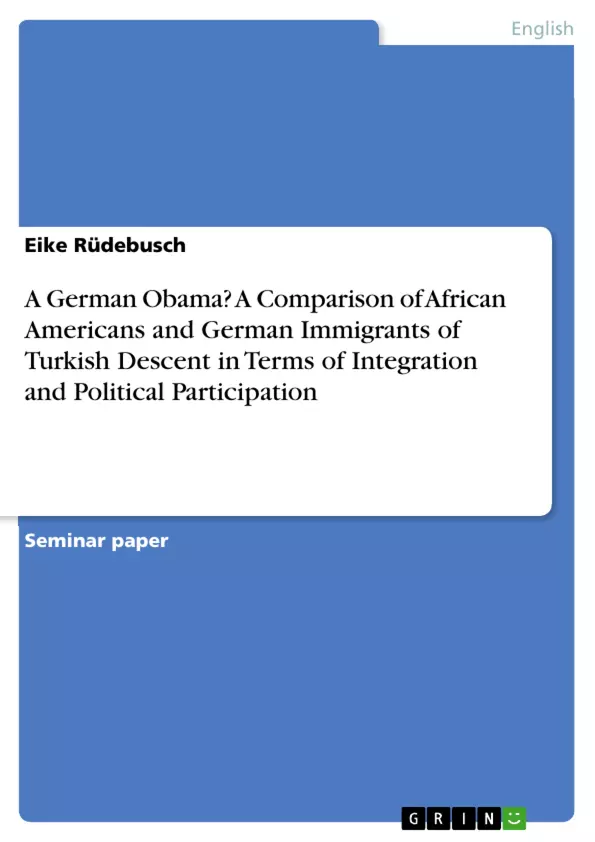Ever since Barack Obama was elected as the 44th President of the United States, it seems that minorities all over the world have gained hope in regard to the possibility of having a minority representative in their specific state's highest office. Especially in Germany, with nearly 20% of its inhabitants being of foreign descent, Obama and his achievements were looked up to. This could be seen on Obama's visit to Berlin in July 2008 when an estimated number of 200,000 people cheered Obama (Zeleni). His election in 2008 set high hopes in Germany which seem to manifest in Cem Oezdemir, one of the leaders of the German Green Party (Buendnis 90/Die Grünen).
Oezdemir is a German politician of Turkish descent. He is a representative of Germany's largest minority. From the 1960s on, Turkish foreign workers, among others, came to Germany to rebuild the state's economy. Many of them did not leave the country as initially planned but rather got their families to emigrate to Germany as well. By now, the Turkish minority is by far the largest minority in Germany. Until today, the Turkish minority is politically underrepresented. Oezedemir seems to be a glimpse of hope for this minority. When Oezdemir was 28, in 1994, he was the first German of Turkish descent to enter the German Bundestag. In November 2008 he was elected to be one of three people heading the Green Party. Thereby, Oezdemir became the first immigrant leader of a German party. His election, shortly after that of Obama's, made the German and international press compare Oezdemir to Obama. Apart from the symbolic similarities, does that comparison make sense? I think it does. This is what I will try to prove in this paper.
In the following, I will point out the similarities and differences between the Turkish minority in Germany and the African American minority in the US. I will focus on the broader groups instead of the particular persons. I will analyze their specific minority's chances in politics. Since a full comparison of both minorities would not be possible in a regular term paper, I will present valid aspects to base the comparison on. Those will be the level of integration and the level of participation of both minorities. With these measurements in mind, I will compare the numbers of citizens, the numbers of representatives in the respective parliament and the numbers of political involved minority members.
Inhaltsverzeichnis (Table of Contents)
- Introduction
- Integration, Political Behavior, and Inclusion
- Germans of Turkish descent and African Americans in Comparison
- Conclusion
Zielsetzung und Themenschwerpunkte (Objectives and Key Themes)
This term paper aims to analyze the similarities and differences between African Americans in the United States and Germans of Turkish descent in Germany, focusing on their integration and political participation. The goal is to determine whether a meaningful comparison can be drawn between Barack Obama and Cem Özdemir, both symbolic figures for their respective minorities.
- Integration and political participation of minorities
- Comparison of African Americans and Germans of Turkish descent
- Role of "linked fate" and socio-economic status in political participation
- Symbolic representation and the potential for a "German Obama"
Zusammenfassung der Kapitel (Chapter Summaries)
The introduction establishes the context for the paper by highlighting the significance of Barack Obama's election and its impact on minority groups around the world, particularly in Germany. It introduces Cem Özdemir as a figure of hope for the Turkish minority in Germany and explores the basis for comparing him to Obama.
The second chapter delves into the concept of integration and its relationship to political participation. It defines various levels of integration, including cultural, social, and identificational integration, and explores factors influencing political participation for African Americans. This chapter introduces the "linked fate," socio-economic status, and fear/threat models as frameworks for understanding political participation.
The third chapter focuses on a comparative analysis of African Americans in the United States and Germans of Turkish descent in Germany. It examines the different waves of immigration to Germany, including guest workers, family reunification, and asylum seekers, and presents data on the size of the Turkish minority in Germany.
Schlüsselwörter (Keywords)
This term paper focuses on the integration and political participation of minority groups. Key concepts include "linked fate," socio-economic status, cultural integration, and symbolic representation. The paper draws comparisons between African Americans and Germans of Turkish descent, analyzing their respective experiences with political participation and the possibility of a "German Obama."
- Quote paper
- B.A. Eike Rüdebusch (Author), 2012, A German Obama? A Comparison of African Americans and German Immigrants of Turkish Descent in Terms of Integration and Political Participation , Munich, GRIN Verlag, https://www.grin.com/document/214920



